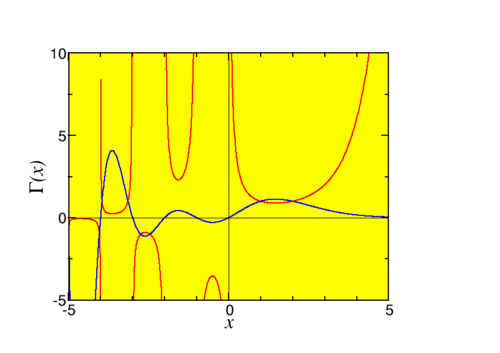
For ν not an integer the recursion relation for the Bessel function generates something very similar to factorials. These quantities are most easily expressed in something called a Gamma-function, defined as
|
Γ(ν) ={\mathop{ \mathop{\mathop{∫
}\nolimits }}\nolimits }_{0}^{∞}{e}^{−t}{t}^{ν−1}dt,\kern 2.77695pt \kern 2.77695pt \kern 2.77695pt ν > 0.
| (10.16) |
Some special properties of Γ function now follow immediately:
The first term is zero, and we obtain
|
Γ(ν) = (ν − 1)Γ(ν − 1)
| (10.18) |
From this we conclude that
|
Γ(2) = 1 ⋅ 1 = 1,\kern 2.77695pt Γ(3) = 2 ⋅ 1 ⋅ 1 = 2,\kern 2.77695pt Γ(4) = 3 ⋅ 2 ⋅ 1 ⋅ 1 = 2,\kern 2.77695pt Γ(n) = (n − 1)!.
| (10.19) |
Thus for integer argument the Γ function is nothing but a factorial, but it also defined for other arguments. This is the sense in which Γ generalises the factorial to non-integer arguments. One should realize that once one knows the Γ function between the values of its argument of, say, 1 and 2, one can evaluate any value of the Γ function through recursion. Given that Γ(1.65) = 0.9001168163 we find
|
Γ(3.65) = 2.65 × 1.65 × 0.9001168163 = 3.935760779.
| (10.20) |
Question: Evaluate Γ(3),
Γ(11),
Γ(2.65).
Answer: 2! = 2,
10! = 3628800,
1.65 × 0.9001168163 = 1.485192746.
We also would like to determine the Γ function for ν < 1. One can invert the recursion relation to read
|
Γ(ν − 1) = {Γ(ν)\over
ν − 1},
| (10.21) |
Γ(0.7) = Γ(1.7)∕0.7 = 0.909∕0.7 = 1.30.
What is Γ(ν) for ν < 0? Let us repeat the recursion derived above and find
|
Γ(−1.3) = {Γ(−0.3)\over
−1.3} = {Γ(0.7)\over
−1.3 ×−0.3} = {Γ(1.7)\over
0.7 ×−0.3 ×−1.3} = 3.33\kern 2.77695pt .
| (10.22) |
This works for any value of the argument that is not an integer. If the argument is integer we get into problems. Look at Γ(0). For small positive ϵ
|
Γ(±ϵ) = {Γ(1 ± ϵ)\over
±ϵ} = ±{1\over
ϵ} →±∞.
| (10.23) |
Thus Γ(n) is not defined for n ≤ 0. This can be easily seen in the graph of the Γ function, Fig. 10.4.

Finally, in physical problems one often uses Γ(1∕2),
This can be evaluated by a very smart trick, we first evaluate Γ{(1∕2)}^{2} using polar coordinates
(See the discussion of polar coordinates in Sec. 7.1.) We thus find
|
Γ(1∕2) = \sqrt{π},\kern 2.77695pt \kern 2.77695pt Γ(3∕2) = {1\over
2}\sqrt{π},\kern 2.77695pt \kern 2.77695pt etc.
| (10.26) |